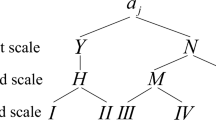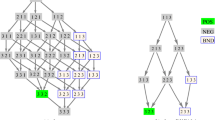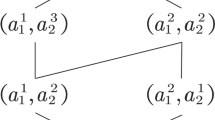Abstract
Optimal scale selection is an important issue in the study of multi-scale decision tables. Most existing optimal scale selection methods have been designed from the perspective of consistency or uncertainty, and cost as well as user requirements or preferences in practical applications has not been considered. It is well known that the uncertainty of decision making in different levels of scale varies in sequential three-way decision models. Furthermore, test cost depends on the scale, and delayed decisions may cause delay cost. In practical applications, both uncertainty and cost are supposed to be considered. Therefore, it is worthwhile to introduce cost-sensitive learning into multi-scale decision tables and select the optimal scale by comprehensively considering uncertainty and cost. In this study, uncertainty is firstly quantified, and a novel cost constitution is defined in sequential three-way decision models. In addition, a multi-scale decision information system based on test cost and delay cost is proposed. Then, to obtain the optimal scale with the minimum uncertainty and cost, an optimal scale selection model is established with the constraint of user requirements. Furthermore, an improved optimal scale selection model considering user preferences is proposed by introducing the ideal solution to resolve conflicts among objectives. Finally, the effectiveness of the optimal scale selection model is verified through experiments, and a comparative experimental analysis demonstrates that the proposed model is more consistent with actual user requirements than existing models.











Similar content being viewed by others
References
Azam N, Yao JT (2014) Analyzing uncertainties of probabilistic rough set regions with game-theoretic rough sets. Int J Approx Reason 55(1):142–155
Ciucci D (2011) Orthopairs: a simple and widely used way to model uncertainty. Fundamenta Informaticae 108:287–304
Guo ZX, Mi JS (2005) An uncertainty measure in rough fuzzy sets. Fuzzy Syst Math 4:135–140
Hao C, Li JH, Min F et al (2017) Optimal scale selection in dynamic multi-scale decision tables based on sequential three-way decisions. Inf Sci 415:213–232
Huang CC, Li JH, Mei CL, Wu WZ (2017) Three-way concept learning based on cognitive operators: an information fusion viewpoint. Int J Approx Reason 83:218–242
Huang YS, Li WH (2012) A study on aggregation of TOPSIS ideal solutions for group decision-making. Group Decis Negot 21(4):461–473
Jia XY, Zheng K, Li WW, Liu TT, Shang L (2012) Three-way decisions solution to filter spam email: an empirical study. Springer, Berlin, pp 287–296
Li F, Hu BQ (2017) A new approach of optimal scale selection to multi-scale decision tables. Inf Sci 381:193–208
Li F, Hu BQ, Wang J (2017) Stepwise optimal scale selection for multi-scale decision tables via attribute significance. Knowl Based Syst 129:4–16
Li HX, Zhang LB, Huang B et al (2016) Sequential three-way decision and granulation for cost-sensitive face recognition. Knowl Based Syst 91:241–251
Li HX, Zhang LB, Zhou XZ, Huang B (2017) Cost-sensitive sequential three-way decision modeling using a deep neural network. Int J Approx Reason 85:68–78
Li JH, Huang CC, Qi JJ et al (2017) Three-way cognitive concept learning via multi-granularity. Inf Sci 378:244–263
Li JH, Mei CL, Wu WH, Qian YH (2015) Concept learning via granular computing: a cognitive viewpoint. Inf Sci 298:447–467
Liang DC, Liu D (2015) A novel risk decision making based on decision-theoretic rough sets under hesitant fuzzy information. IEEE Trans Fuzzy Syst 23(2):237–247
Liang DC, Pedrycz W, Liu D, Hu P (2015) Three-way decisions based on decision-theoretic rough sets under linguistic assessment with the aid of group decision making. Appl Soft Comput 29:256–269
Liu D, Li TR, Liang DC (2014) Incorporating logistic regression to decision-theoretic rough sets for classifications. Int J Approx Reason 55(1):197–210
Liu D, Liang DC (2016) Generalized three-way decisions and special three-way decisions. J Front Comput Sci Technol 11(3):502–510
Liu D, Liang DC (2017) Three-way decisions in ordered decision system. Knowl Based Syst 137:182–195
Luo C, Li TR, Yang YY et al (2019) Updating three-way decisions in incomplete multi-scale information systems. Inf Sci 476:274–289
Ma XA, Yao YY (2018) Three-way decision perspectives on class-specific attribute reducts. Inf Sci 450(1):227–245
Min F (2012) Attribute reduction of data with error ranges and test costs. Inf Sci 211(211):48–67
Min F, He HP, Qian YH et al (2011) Test-cost-sensitive attribute reduction. Inf Sci 181(22):4928–4942
Pawlak Z (1982) Rough sets. Int J Comput Inf Sci 11(5):341–356
Pawlak Z, Skowron A (1993) Rough membership functions: a tool for reasoning with uncertainty. Algebr Methods Log Comput Sci 28:135–150
Pedrycz W, Homenda W (2013) Building the fundamentals of granular computing: a principle of justifiable granularity. Appl Soft Comput 13(10):4209–4218
Qi JJ, Qian T, Wei L (2016) The connections between three-way and classical concept lattices. Knowl Based Syst 91:143–151
She YH, Li JH, Yang HL (2015) A local approach to rule induction in multi-scale decision tables. Knowl Based Syst 89:398–410
Shivhare R, Cherukuri AK (2017) Three-way conceptual approach for cognitive memory functionalities. Int J Mach Learn Cybern 8(1):21–34
Skowron A, Stepaniuk J, Swiniarski R (2012) Modeling rough granular computing based on approximation spaces. Inf Sci 184(1):20–43
Ucirvine machine learning repository (2019). http://archive.ics.uci.edu/ml/
Wang GY (2001) Rough set theory and knowledge discovery. Xian Jiaotong University Press, Xi’an
Wang GY, Yang J, Xu J (2017) Granular computing: from granularity optimization to multi granularity joint problem solving. Granul Comput 2(3):1–16
Wang R, Wang XZ, Kwong S et al (2017) Incorporating diversity and informativeness in multiple-instance active learning. IEEE Trans Fuzzy Syst 25(6):1460–1475
Wang XZ, Xing HJ, Li Y et al (2015) A study on relationship between generalization abilities and fuzziness of base classifiers in ensemble learning. IEEE Trans Fuzzy Syst 23(5):1638–1654
Wang XZ, Wang R, Xu C (2018) Discovering the relationship between generalization and uncertainty by incorporating complexity of classification. IEEE Trans Cybern 48(2):703–715
Wu WZ, Leung Y (2019) A comparison study of optimal scale combination selection in generalized multi-scale decision tables. Int J Mach Learn Cybern. https://doi.org/10.1007/s13042-019-00954-1
Wu WZ, Leung Y (2013) Optimal scale selection for multi-scale decision tables. Int J Approx Reason 54(8):1107–1129
Wu WZ, Leung Y (2011) Theory and applications of granular labelled partitions in multi-scale decision tables. Inf Sci 181(18):3878–3897
Wu WZ, Qian YH, Li TJ, Gu SM (2017) On rule acquisition in incomplete multi-scale decision tables. Inf Sci 378:282–302
Xie JP, Yang MH, Li JH, Zheng Z (2018) Rule acquisition and optimal scale selection in multi-scale formal decision contexts and their applications to smart city. Future Gener Comput Syst 83:564–581
Yang CC, Zhang QH, Wang GY, Zhao F (2019) Hierarchical three-way decisions with intuitionistic fuzzy numbers in multi-granularity spaces. IEEE Access 7(1):24362–24375
Yang X, Li TR, Fujita H, Liu D, Yao YY (2017) A unified model of sequential three-way decisions and multilevel incremental processing. Knowl Based Syst 134:172–188
Yao JT, Vasilakos AV, Pedrycz W (2013) Granular computing: perspectives and challenges. IEEE Trans Cybern 43(6):1977–1989
Yao YY, Deng XF (2011) Sequential three-way decisions with probabilistic rough sets. In: Proceedings of the 10th IEEE international conference on cognitive informatics and cognitive computing, Banff, Canada, pp 120–125
Yao YY (2013) Granular computing and sequential three-way decisions. In: Proceedings of the 8th international conference on rough sets and knowledge technology, Halifax, Canada, pp 16–27
Yao YY (2017) Interval sets and three-way concept analysis in incomplete contexts. Int J Mach Learn Cybern 8(1):3–20
Yao YY (2011) The superiority of three-way decisions in probabilistic rough set models. Inf Sci 181(6):1080–1096
Yao YY (2016) Three-way decisions and cognitive computing. Cognit Comput 8(4):543–554
Yao YY (2010) Three-way decisions with probabilistic rough sets. Inf Sci 180(3):341–353
Yu H, Zhang C, Wang GY (2015) A tree-based incremental overlapping clustering method using the three-way decision theory. Knowl Based Syst 91:189–203
Zhang HR, Min F (2016) Three-way recommender systems based on random forests. Knowl Based Syst 91:275–286
Zhang QH, Lv GX, Chen YH, Wang GY (2018) A dynamic three-way decision model based on the updating of attribute values. Knowl Based Syst 142:71–84
Zhang QH, Xia DY, Wang GY (2020) A general model of decision-theoretic three-way approximations of fuzzy sets based on a heuristic algorithm. Inf Sci 507:522–539
Zhang QH, Xia DY, Wang GY (2017) Three-way decision model with two types of classification errors. Inf Sci 420:431–453
Zhang QH, Xie Q, Wang GY (2018) A novel three-way decision model with decision-theoretic rough sets using utility theory. Knowl Based Syst 159:321–335
Zhang QH, Yang CC, Wang GY (2019) A sequential three-way decision model with intuitionistic fuzzy numbers. IEEE Trans Syst Man Cybern Syst. https://doi.org/10.1109/TSMC.2019.2908518
Zhang QH, Zhang Q, Wang GY (2016) The uncertainty of probabilistic rough sets in multi-granulation spaces. Int J Approx Reason 77:38–54
Zhang Y, Zhou ZH (2010) Cost-sensitive face recognition. IEEE Trans Pattern Anal Mach Intell 32(10):1758–1769
Zhao H, Wang P, Hu QH (2016) Cost-sensitive feature selection based on adaptive neighborhood granularity with multi-level confidence. Inf Sci 366:134–149
Zhao H, Zhu W (2014) Optimal cost-sensitive granularization based on rough sets for variable costs. Knowl Based Syst 65(4):72–82
Acknowledgements
This work is supported in part by the National Key Research and Development Program of China under Grant 2017YFC0 804002, the National Natural Science Foundation of China under Grants 61876201 and 61876027, and the Talent Development Project of Guizhou Province under Grant KY(2018)No.31.
Author information
Authors and Affiliations
Corresponding author
Additional information
Publisher's Note
Springer Nature remains neutral with regard to jurisdictional claims in published maps and institutional affiliations.
Rights and permissions
About this article
Cite this article
Zhang, X., Zhang, Q., Cheng, Y. et al. Optimal scale selection by integrating uncertainty and cost-sensitive learning in multi-scale decision tables. Int. J. Mach. Learn. & Cyber. 11, 1095–1114 (2020). https://doi.org/10.1007/s13042-020-01101-x
Received:
Accepted:
Published:
Issue Date:
DOI: https://doi.org/10.1007/s13042-020-01101-x




